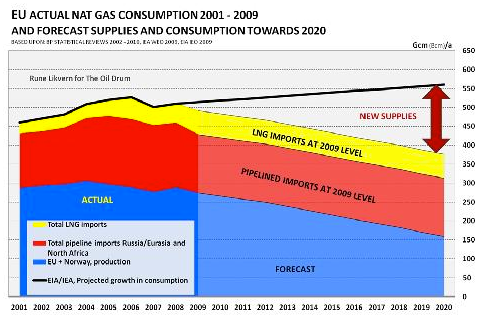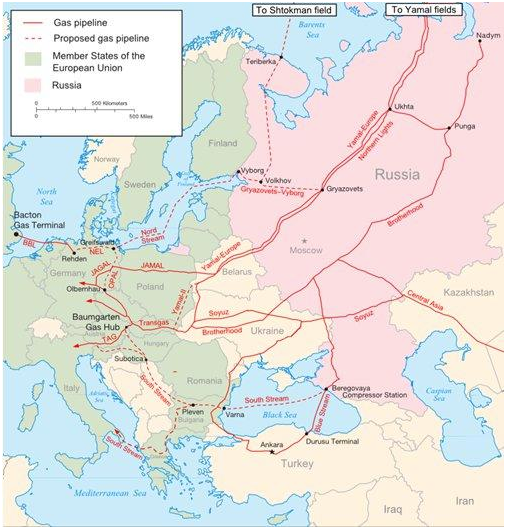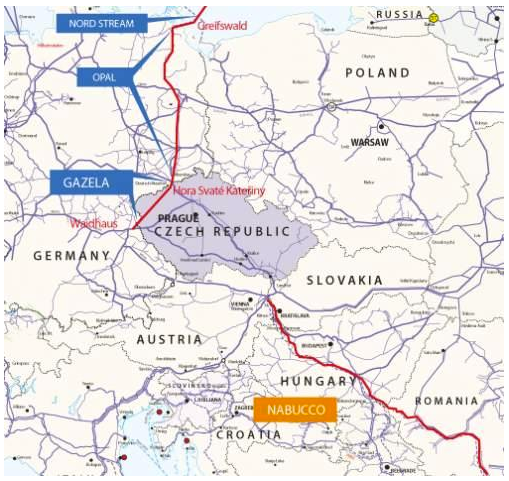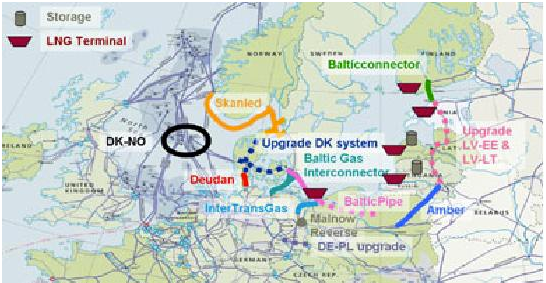February Cold Wave Snaps EU Russia Gas Relations
The European Union (EU) has elevated its natural gas relations with Russia to one of the most preeminent issues on its energy security agenda. Since the last energy crisis in 2009 when gas supplies to the EU were interrupted as a result of a pricing dispute between Russia and Ukraine, the EU has managed to enhance the energy security of its member states by implementing a variety of internal safeguards that should protect EU member states in the case of a future short term gas crises. These measures proved handy in February 2012 when Russia reduced natural gas supplies to nine EU member states by up to 30% in order to meet a surge in domestic demand caused by a cold snap that paralyzed the continent. This gas crisis, coupled with Vladimir Putin’s re-election to Russia’s presidency in March 2012, should serve as an alarm that future threats to EU energy security may derive not only from Putin’s renewed use of energy as a tool of foreign policy manifested in politically motivated gas supply disruptions, but also from Russia’s weakness and perhaps even unwillingness to increase its domestic production – despite holding the world’s largest natural gas reserves. In a light of these prospects, even enhanced protection against short-term gas shortages may prove highly insufficient in providing EU member states with long term energy security unless the EU addresses the core of the problem, namely Russia’s restrictive gas policy. So far this has been increasingly difficult to achieve. Moreover, with EU member states unable to speak with one voice vis-a-vis Russia on a natural gas policy and with a single EU-wide gas market far from complete, the EU will likely continue to fail to shape its natural gas relations with Russia to its advantage.
Background
The EU’s gas imports are projected to accelerate due to a depletion of indigenous gas resources. The European Commission estimates that the proportion of EU gas consumption met from imports is set to rise from 60% to 73-79% by 2020 and 81-89% by 2030 (see figure 1). Moreover, despite ambitious plans to become a low carbon economic area, the current financial crisis within the Eurozone has already, and will likely continue, to slow down the implementation of highly subsidized sources of renewable energy. An estimate from 2011 is that for renewable energy alone, EU member states need €70 billion of capital investment every year until 2020 to meet energy efficiency and climate objectives endorsed in the 2007’s “20-20-20” directive, under which EU member states agreed on a 20% cut in emissions of greenhouse gases by 2020; a 20% increase in the use of renewable energy; and a 20% cut in energy consumption - all compared with 1990 levels. However, by 2008, only half or €35 billion had been spent to reach this target. These expenditures have taken the form of outright private investment as well as preferred feed-in tariffs for renewable energy, tax incentives, and investment grants just to name a few. Furthermore in November 2011, Philip Lowe, the European Commission’s director general for energy, indicated that the chance that the 20% targets would be met by 2020 is only 60%. Also, according to theEnergy Roadmap for 2050 issued in 2011, the EU “is far from reaching its 20% objective” due to “investment decisions at all levels – public, commercial and private.” For all these reasons, a long-term and stable supply of natural gas remains a critical and growing component of the EU’s energy-mix into the foreseeable future with Russia posed to remain EU’s important natural gas supplier.
Figure 1

Source: Rune Likvern, “Europe and Natural Gas – Are Tough Choices Ahead?” The Oil Drum: Europe, August 3, 2010
EU strategy vis-a-vis Russia
The EU’s chief objective in dealing with Russian energy has been to lure Russia into a common regulatory space based on market rules, and clear governance structures underpinned by transparency and reciprocity. The EU envisioned that the Energy Charter Treaty (ECT), which Russia signed in 1994 but which it never ratified, would place Russia’s pipeline network under multilateral regulations and dismantle Gazprom’s monopoly thus introducing competition on Russia’s domestic gas market. This was followed by the establishment of the EU-Russia energy dialogue in 2000 which has continued EU efforts to integrate the continent’s energy market, with the ultimate goal to drive gas sector reform in Russia that would facilitate inward foreign investment into its energy matrix.
In order to sustain the current levels of production and meet future domestic and foreign demand, Russia needs to replace depleted deposits in western Siberia with new fields in the Arctic north. It plans to increase natural gas production from 664 bcm in 2008 to between 885-940 bcm by 2030. This is necessary because domestic demand itself is projected to increase by 32%-40% from 457 bcm in 2008 to 605-64 bcm by 2030. Moreover, before the global recession which depressed gas demand in Europe, Russia had already depended on supplies of cheaper gas from Turkmenistan to cover its domestic demand foreign export commitments. According to its energy growth plan to 2030 released by Russian Ministry of Energy, Russia plans to invest $565 - $590 billion in its natural gas sector to meet the production targets. Also by 2030, $277 - $289 billion of this sum is needed to develop new pipeline infrastructure and simply to maintain its existing pipeline infrastructure 67% of which is more than 20 years old.
The problem is that the Russian government and its indebted $30 billion state gas monopoly Gazprom can barely develop new fields, located in the harsh environmental conditions of Arctic north, without Western investment and technology. Such investments are however not easy to secure due to the restrictive conditions of Russia’s nationalized energy sector. Although in February 2012 Vladimir Putin indicated that “We have to work out what more should be done to increase opportunities” for non-state companies to access lucrative Arctic offshore gas deposits, his former record of depriving western businesses of energy assets in Russia combined with weak property rights, and tough Russian laws on foreign investment in strategic mineral fields, may easily discourage Western companies from being heavily engaged in these demanding projects.
Besides being highly susceptible to shifting moods inside the Kremlin, these production and investment targets are moreover subject to adjustment in case of changes in market conditions and energy needs in Russia itself and abroad. In the current climate, Russia’s decision whether to fully embark on these projects is complicated by uncertainty about future gas demand, rising competition from unconventional gas supplies, and most importantly, by a mixed message from the EU pertaining to its future energy security related strategies. There is a cacophony of voices here, ranging from the EU discourse about gas supply diversification to the willingness of the EU’s biggest powers to increase their dependency on Russian gas, which exacerbates EU efforts to break the traditional long-term contracts and oil-linked price index for gas. From Gazprom’s perspective however, only long-term contracts constitute a firm basis for investments and “ensure financing for the capital-intensive infrastructure and field developments.
Lastly, with the re-election of Putin in March 2012, the politicization of energy relations and a renewed willingness to use supply cut-offs as a form of coercive diplomacy against EU members cannot be ruled out. As he argued already in 1999 and then systematically demonstrated during previous presidencies, Russia’s vast energy resources serve not only as a base to develop its economy but also “as an instrument to implement domestic and foreign policy;” admitting that, “The role of the country on international energy markets determines, in many ways, its geopolitical influence.”
To address these threats, the EU has attempted to increase competition in the EU gas market and to exert pressure on Russia. Despite these attempts, the EU’s success in both of these areas has been mixed at best. Some competition has been introduced by supplies of liquefied natural gas (LNG) and there is a potential for more competition if current plans to build new gas pipelines and LNG terminals materialize. However, Russia keeps it restrictive domestic gas policy adamantly intact by keeping its internal gas market closed and far from transparent.
In terms of reciprocity, in July 2007 the EU opened its gas market to domestic and foreign companies enabling Gazprom to sell gas directly to EU customers. Russia, in return, still does not allow foreign companies to access its vast network of pipelines. Moreover, Russian officials show increasing disinterest in adopting European norms and standards. This was most recently demonstrated by Russia’s unilateral withdrawal from the Energy Charter Treaty in 2009.
Variation in dependency
One of the main obstacles preventing the EU to speak with one voice vis-a-vis Russia on natural gas is the variation among member states’ level of dependence and size of their gas markets, with Russia being skillfully able to exploit these variations. For the EU as a whole, the import of Russian gas accounts only to 6.5% of EU primary energy consumption. This means that “93.5% of energy consumed in the EU is covered by sources other than Russian gas.” However, since a single, EU-wide gas market is far from complete, national differences in gas dependency remain critical. Out of 218 bcm of natural gas that Russia sold abroad in 2010, around 70% went to the EU, with approximately a half of this amount being imported by Germany, Italy and France. The energy mix of these EU member states is however well diversified with imports of Russian gas constituting only between 5 – 10% of their primary overall energy consumption. Since these states are Gazprom’s most lucrative natural gas customers and at the same time their level of dependence is not high enough to make them easy targets of political coercion, Russia prefers to cultivate cooperative and mutually beneficial relationships. In turn, these amicable bilateral relationships contribute to these EU member states’ reluctance to surrender their sovereignty over decision making on gas policy vis-a-vis Russia to the EU supranational level – an act which would act as an irritant to Russia.
The situation is completely different for the Central and Eastern European EU member states (CEE). This is because all CEE states, apart from Romania, rely on Russia for at least 50% of their gas consumption, and for six of them dependence on Russian gas reaches 80% or more. Despite this high level of dependency, CEE members import smaller volumes of gas compared to their neighbors given the relative size of their gas markets. For instance, Slovakia, Bulgaria and the Baltic states import almost 100% of their gas needs from Russia. Yet, combined gas imports for Latvia and Estonia, as an example, amount to only 1 bcm of Russian natural gas as compared to 35 bcm imported by Germany. Since many CEE members account for only a tiny fraction of Gazprom’s exports and profits, and with Russia being in the vast majority of cases their sole natural gas supplier, they are easily vulnerable targets of Russia’s politicized energy policy. Understandably, these are the states calling for greater EU integration, and a common and tougher stance the gas relations with Russia.
A single gas market as a precondition
The success of the EU’s gas policy vis a vis Russia is to a great extent contingent on the completion of the single gas market within the EU – the market that the EU envisioned almost two decades ago. If such a market was in a place, the EU would become a single export market for Gazprom, making bilateral relations and contracts much less critical. A disruption of supply to one of the EU members would be covered by the re-allocation of available gas based on supply and demand within the EU; the same way as oil and liquefied natural gas is traded today on the global market. However, this would be the case only if key gas interconnecting pipelines between individual EU member state gas markets are built. Not only would a single gas market make Russia’s targeted gas disruptions ineffective, it would also introduce more competition to Russian gas and increase the access of CEE members to gas from other sources. Gas relations would be de-politicized and as a result, the EU members would face fewer obstacles to speak with one voice to Russia. Despite these advantages, internal market segmentation, insufficient interconnecting infrastructure, different pricing, and the reluctance of the big EU members for greater integration have prevented this from occurring.
Variation in perceptions: Russia is the solution
Individual EU states’ commercial interests and diverging views about Russia’s role in the EU’s future energy security help explain why the EU has been unable, and will likely continue to struggle, to exert leverage in dealing with Russia on gas. Particularly, Germany, France and Italy view Russia as a solution to Europe’s energy security, with all parties having self-serving interests. Gazprom strives for further expansion into Europe’s downstream retail gas market using these countries’ utility companies as gate keepers for Russian gas; in return for this access, these companies hope to gain access to Russia’s otherwise closed upstream market and to conclude long term bilateral gas contracts. These states are also among those resisting transparency and information-sharing with the Commission on their bilateral gas deals with Gazprom. The utility companies of these states, not the EU, were also the ones able to extract 10% price reduction on natural gas for their long-term contracts with Russia in the wake of the changing gas conditions in Europe triggered by a global gas glut.
These mutually serving relationships have manifested themselves most notably in the launch of the Nord Stream pipeline in 2011 and in continuing efforts to build the South Stream natural gas pipeline which illustrates that these states are not concerned about increasing Russian gas dependency (see Figure 2). Besides Gazprom, German utility company E.ON Ruhrgas and French GDF Suez are major shareholders in Nord Stream with Italian companies receiving $2 billion worth contracts for the project. In March 2012, Russian Prime Minister Vladimir Putin indicated that also the UK may consider joining the Nord Stream pipeline, since in 2011 UK’s domestic natural gas production declined 20% compared to 2010 levels. According to Putin, “negotiations have started.” South Stream which has been competing with EU-backed Nabucco pipeline is also a joint project of Gazprom, Italian Eni, German Wintershall Holding and French EDF. This project recently gained traction, with all shareholders signing the Agreement for the offshore section of the project in September 2011. First gas deliveries via the pipeline are planned for late 2015.
Figure 2 North and South Stream Pipelines

Source: BBC
Without the EU-wide gas market, the Czech Republic is the only country in the CEE region to benefit from the Nord Stream pipeline thanks to the Gazelle pipeline which passes Nord Stream gas from Germany to the Czech Republic (see figure 3). Together, Nord Stream and South Stream (if built) will reduce the traditional supply routes for Russian gas through Poland, Ukraine, Slovakia, and to a lesser extent, Hungary. Except redirecting Russian natural gas from one route to another, these bilaterally negotiated pipelines do nothing in terms of fostering a rule-based reciprocal relationship with Russia on gas relations, or in terms of increasing energy security by reducing EU dependence on Russian gas. What these pipelines will do however is to further expose already vulnerable CEE states, while legitimizing Russia’s way of doing business.
Figure 3 Gazelle Pipeline

Source: CzechPosition.com, 2010
Compared to other EU member states, the German energy sector has the closest relationship with Russia. Germany, which imports 40% of its natural gas needs from Russia, is also Russia’s best customer annually importing around 35 bcm, with Italy being its second largest customer, importing around 13 bcm. The relationship between the two countries has become highly commercially beneficial since German energy companies such as RWE, E.ON Ruhrgas, and Wintershall have become major joint venture partners of Gazprom; with German E.ON celebrating 20 years of cooperation with Gazprom in July 2010. WINGAS is another joint venture between Gazprom and Germany’s Wintershall, achieving record sales in 2010. WINGAS is one of Germany’s largest gas suppliers and it is actively operating in its own domestic market, as well as in Belgium, the Netherlands, Britain, France, Austria, the Czech Republic and Denmark.
As Gerhard Schröder, the former Chancellor of Germany, and Chairman of the Board of Nord Stream, expressed “Russia is much more dependent on Europe since European Union receives 60% of Russian gas exports,” adding that in comparison with alternative natural gas suppliers from North Africa or the Middle East, Russia is “a more important and stable partner.” Moreover, a phase-out of nuclear energy in Germany, as well as the slow and expensive development of renewable energy sources, contributes, according to Schröder, to Germany’s view about Russia being a source of a stable and affordable gas supply.
Also France is a main strategic partner of Gazprom in the natural gas sector, with Gazprom closely cooperating with three major French companies, GDF-Suez, Total and EDF. GDF-Suez holds a 9% stake in Nord Stream gas pipeline, with Total holding a 25% stake in Russia’s Shtokman field development, and with EDF being a shareholder in the planned South Stream pipeline. Total, which is already developing a series of fields south of the Russia’s Yamal peninsula, will also take a 20% stake in the Yamal liquefied natural gas (LNG) project. France’s position was clearly illustrated after the February 2012 gas crisis. Instead of triggering concerns about Russia’s inability to simultaneously meet a surge in domestic and EU’s gas demand, the cold snap in February 2012 further cemented France’s view about a need to increase Russia’s role in Europe’s energy security. This was demonstrated when France and Gazprom met after the crisis to discuss new direct pipeline options to Europe while highlighting the relevancy of Nord Stream in ensuring supply to Europe, indirectly supporting Russian accusations of Ukraine’s contested role in the crisis. The point however is that regardless of whether the accusations of Ukraine siphoning EU-bound transit gas are legitimate or not, Russia should have been able to increase supply of gas to all of its customers when needed. By encouraging Russia to build new direct pipelines to Europe instead of addressing the core of the problem, France has undermined EU-led efforts while stripping traditional transit countries of their sole leverage vis-a-vis Russia.
Russia is the problem
The position of these states contrasts with the position of the majority of CEE members which view their energy dependency on Russia as a threat to their energy security. Particularly, the three Baltic states, the Czech Republic, and Poland have been victims of past Russian energy disruptions. These states have watched with frustration as Germany, France and Italy have concluded preferential gas contracts with Russia. Since these and other EU member states have shown little solidarity or serious intent to devise and enforce a common natural gas policy, they too have to often look for bilateral natural gas deals with Russia to secure their own immediate energy interests. For instance, Bulgaria, Serbia, Hungary, Greece, Slovenia, Croatia and Austria eagerly signed agreements with Gazprom on the South Stream pipeline whose gas will transit their territories.
Despite the EU’s failure to convince Russia to reform its restrictive natural gas policy, the 10 CEE states that have pushed for the EU to play a bigger role in negotiations with Russia on natural gas succeeded in having energy supply security and a solidarity clause as part of the 2009 Lisbon Treaty. In theory, they should now be better protected against Russian initiated and politically motivated gas supply disruptions. These states were also behind the Commission’s proposal to have all energy deals vetted or negotiated by the EU; with Poland asking the Commission to co-negotiate Poland’s deal with Gazprom concerning the extension of gas for the Yamal pipeline running from Russia via Poland to Germany. As a result, Poland was able to conclude a better deal, namely the right of third party access to the pipeline, to re-sell unconsumed Gazprom’s gas, and to re-import gas back from Germany by building a new reverse flow mechanism on the pipeline. Not only will other suppliers have access to Yamal gas, but with a progress in gas market interconnections, Poland will be, for the first time, able to access gas from the West.
Moreover, some of the CEE members have joined their own forces in a sub-regional coalition manifested in the Visegrad+ Group, including the Czech Republic, Hungary, Slovakia, and Poland as member states of the Visegrad Group, as well as Austria, Bosnia and Herzegovina, Bulgaria, Croatia, Serbia Slovenia and Romania. The V4+ group held an Energy Security summit in Budapest in February 2010 where they discussed the completion of an interconnected liquid gas market in the CEE region. To facilitate this project, the EU earmarked €30 million to co-finance the North-South gas corridor which will not only interconnect all the CEE countries but will also inject liquidity into these isolated markets by linking them to planned LNG terminals in Poland and Croatia; thereby giving them access to global, spot-priced LNG delivered from all around the world (see Figure 4). If this corridor becomes a reality, these countries will have for the very first time the prospect to alleviate their Cold War heritage of being hostages to Russian gas which has historically flown only from East to West. Moreover, under the EU’s Baltic Energy Market Interconnection Plan (BEMIP), also Baltic states plan to be connected to central Europe and build an LNG terminal.
Furthermore, CEE governments that quickly privatized their major energy infrastructure after the Cold War and consequently have seen their gas industry bought up and controlled by Russian state companies now have an option to reverse their decision. Armed with regulations under the EU Third Energy Package which came into effect in May 2011, Lithuania has for instance decided to choose the most drastic of the three ownership unbundling alternatives, namely full separation of ownership of gas supply and transportation assets. As a result, Gazprom which holds 37.1% of national gas monopoly, Lietuvos Dujos, will have to cede its ownership over the country’s pipelines, therefore enabling Lithuania’s government to regain control of its major gas infrastructure. As an alternative to Gazprom’s supplies, Lithuania is planning to take the advantage of the EU’s Amber pipeline project which will link the country with Poland’s planned LNG terminal due to come on-stream in 2015. Also Estonia announced it would break Russian Gazprom’s and German’s E.ON Ruhrgas grip over its energy market by splitting up the national gas monopoly, Eesti Gaas, to open up its energy market to competition allowing different suppliers to compete for distribution rights.
Figure 4 CEE and LNG Access

Source: European Commission, 2009
Conclusion
Although the long term outcome these developments is yet to be seen, the EU has achieved some progress in moving the completion of the EU internal gas market forward and in enhancing energy security and negotiating power of CEE members in their natural gas relations with Russia. It has also enhanced EU member states energy security in a case of temporary gas shortages. Despite this progress, the EU has failed to maximize its power in its gas relations with Russia which continues to successfully resist all EU led efforts to force it to abide by any rules. As long as Germany, Italy and France keep expanding their gas cooperation with Russia on a bilateral basis, and thereby legitimizing Russia’s way of doing business, an effective EU-wide policy on gas relations with Russia that would provide long term energy security for all will continue to be most notable for its absence.
This article by Katerina Oskarsson was published in the April 2012 issue of Journal of Energy Security


